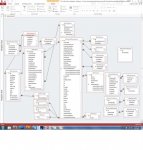I've deleted all my queries and forms and gone back to my tables on this workflow database. I was being a little bit of a maniac because I hit a wall, but now that I've calmed it down a bit I would like to as all of you lovely experts for your opinion on how to approach this.
I am teaching myself. Apologies in advance for butchered terms.
I have tblProjects. There can be only 1 customer per project, and there are certain fields that apply to the entire project (payment, etc). Within each project, there can be multiple tblStockArtProduction entries (within each StockArtProduction entry the fields are all dependent- I tried to break it up before but it was just a bunch of messy 1-1 relationships).
My original plan was to have a Projects Form with StockArtProduction as a subform. But the StockArtProduction subform MUST only show previous entries from, and add new entries to, the open Project for this to be an effective database.
I hit my wall in the last version with new subform entries. I could not get it to automatically add just to that Project (auto populate?). The employee would have to manually pick that Project... and I honestly just don't trust them to do that. (I still have this version if anyone has a thought to make it salvageable. It was looking pretty.)
So, now I'm open-minded. The Project and StockArtProduction relationship is the heart of this whole project. Employees will need to view both as a whole (we call it a workorder) throughout the life of the project. Other than that, I am willing to entertain any and all thoughts of how to structure.
I currently have a version they're using that just has a bunch of repeated blanks for StockArtProduction in the Projects form. But I want to do this the right way- build for longevity and flexibility so I won't have to do this from scratch again in another 2 years.
I have included my tables and relationships if it helps or inspires suggestions.
Please please please help. I can send you anything you need. Including money. But seriously, I'm outside my paygrade on this. Appreciate it.
I am teaching myself. Apologies in advance for butchered terms.
I have tblProjects. There can be only 1 customer per project, and there are certain fields that apply to the entire project (payment, etc). Within each project, there can be multiple tblStockArtProduction entries (within each StockArtProduction entry the fields are all dependent- I tried to break it up before but it was just a bunch of messy 1-1 relationships).
My original plan was to have a Projects Form with StockArtProduction as a subform. But the StockArtProduction subform MUST only show previous entries from, and add new entries to, the open Project for this to be an effective database.
I hit my wall in the last version with new subform entries. I could not get it to automatically add just to that Project (auto populate?). The employee would have to manually pick that Project... and I honestly just don't trust them to do that. (I still have this version if anyone has a thought to make it salvageable. It was looking pretty.)
So, now I'm open-minded. The Project and StockArtProduction relationship is the heart of this whole project. Employees will need to view both as a whole (we call it a workorder) throughout the life of the project. Other than that, I am willing to entertain any and all thoughts of how to structure.
I currently have a version they're using that just has a bunch of repeated blanks for StockArtProduction in the Projects form. But I want to do this the right way- build for longevity and flexibility so I won't have to do this from scratch again in another 2 years.
I have included my tables and relationships if it helps or inspires suggestions.
Please please please help. I can send you anything you need. Including money. But seriously, I'm outside my paygrade on this. Appreciate it.







